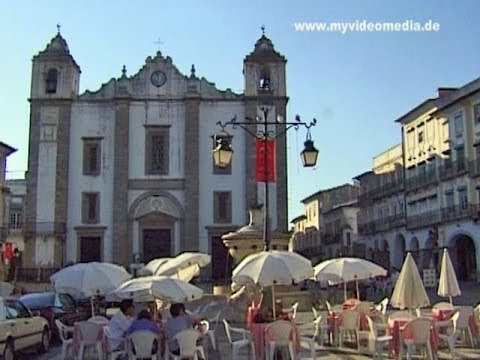
Evora, located in the heart of Portugal – the Alentejo region – was already inhabited in the Neolithic period. Evora was extended during the colonization of Portugal by the Romans. A huge viaduct, the castle and the beautiful Diana Temple are surviving memorials of this period. Later the Moors enlarged the castle and built a mosque.
Geraldo Geraldes the Fearless (Geraldo Sem Pavor) conquered Evora for King Afonso Henriques. The Moors were finally expelled with the support of the order of knights of the Avis. In 1166, the Avis made Évora their initial seat and named the order of knights Évora. A still largely preserved wall had been built to protect the town. Since the 12th century Portugal’s kings were crowned in Évora. The town blossomed out to a centre of the humanism. In 1973 the University – founded in 1559 – was reopened after being closed in 1759. Évora had lost influence after the affiliation to Spain.
Other attractions include the Sé Cathedral, Palace of the Dukes of Cadaval and the Chapel of Bones (Capela dos Ossos).
Since 1986 Évora belongs to the UNESCO World Heritage Site.
……
please read more://
Évora, im Herzen Portugals in der Region Alentejo gelegen, war bereits im Neolithikum besiedelt. Als die Römer das Land besiedelten, bauten sie in Evora aus. Ein riesiges Viadukt, die Burg und der prächtige Diana — Tempel sind aus jener Zeit noch erhalten. Später erweiterten die Mauren die Burg und bauten eine Moschee.
Geraldo Geraldes, o Sem Pavor (= Gerald ohne Furcht) eroberte Évora für König Afonso Henriques. Endgültig vertrieben wurden die Mauren mit der Unterstützung des Ritterordens von Avis. Dieser macht Évora 1166 zu seinem anfänglichen Sitz und nennt sich auch Ritterorden Évora. Zur Befestigung der Stadt wird eine, noch weitestgehend erhaltene, Mauer gebaut. Seit dem 12. Jahrhundert ließen sich Portugals Könige in Évora, das zu einem Zentrum des Humanismus aufblühte, krönen. 1973 wird die 1559 gegründete Universität wieder eröffnet, nachdem sie 1759 geschlossen wurde. Évora hatte nach der Angliederung an Spanien an Einfluss verloren.
Weitere Sehenswürdigkeiten sind die Kathedrale Sé, der ehemalige Königssitz Paço dos Condes de Basto und das Beinhaus Capela dos Ossos.
Seit 1986 zählt Évora zum Weltkulturerbe der UNECO.
…
Weitere Infos im Reisevideoblog:
source